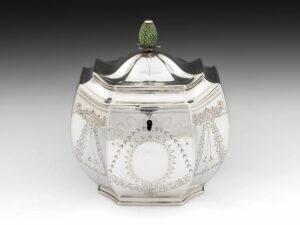John Robins
John Robbins worked in Birmingham, which, along with London and Sheffield, was one of the main centers of silversmithing in England during the 18th and 19th centuries. Birmingham’s Assay Office, established in 1773, allowed silversmiths like Robbins to hallmark their silver locally.
Robbins was active in silversmithing during the mid-19th century, a period when the British silver industry was flourishing, especially in the decorative arts.
Hallmarks and Identification:
Pieces crafted by John Robbins are marked with his initials, typically “J.R.”, as part of the hallmarking system in place in Birmingham. His hallmark is used to identify his work and authenticate it as part of the English silversmithing tradition.
Robbins’ silverware often bears the hallmark for Birmingham, indicating its origin and the high standard associated with silver from the region.
Specialty and Styles:
John Robbins created various types of silverware, including tableware, flatware, and decorative items. His works reflected the Victorian taste for ornamentation, often including floral motifs, engraving, and other decorative elements typical of the period.
His pieces tended to be elegant and functional, and like many silversmiths of his time, Robbins catered to the rising middle class, who sought fine silverware for their dining tables and homes.
Popularity and Collectibility:
While John Robbins may not be as famous as some of the larger silversmithing firms from the era, his work is appreciated by collectors for its craftsmanship and quality.
His silver pieces, particularly those in good condition and with clear hallmarks, are collectible and can sometimes be found at auctions or in antique shops specializing in British silver.
Victorian Craftsmanship and Legacy:
Robbins’ work captures the essence of Victorian silver craftsmanship, a period known for intricate designs and an appreciation for fine silver in British households.
His pieces are often included in collections that focus on Victorian silverware, and they hold value as representations of the period’s design sensibilities.
In summary, John Robbins was a skilled 19th-century British silversmith whose work exemplifies Victorian craftsmanship and the rich silversmithing tradition of Birmingham. His pieces are valued for their quality, design, and role in the broader history of British decorative arts.
John Robins
John Robbins worked in Birmingham, which, along with London and Sheffield, was one of the main centers of silversmithing in England during the 18th and 19th centuries. Birmingham’s Assay Office, established in 1773, allowed silversmiths like Robbins to hallmark their silver locally.
Robbins was active in silversmithing during the mid-19th century, a period when the British silver industry was flourishing, especially in the decorative arts.
Hallmarks and Identification:
Pieces crafted by John Robbins are marked with his initials, typically “J.R.”, as part of the hallmarking system in place in Birmingham. His hallmark is used to identify his work and authenticate it as part of the English silversmithing tradition.
Robbins’ silverware often bears the hallmark for Birmingham, indicating its origin and the high standard associated with silver from the region.
Specialty and Styles:
John Robbins created various types of silverware, including tableware, flatware, and decorative items. His works reflected the Victorian taste for ornamentation, often including floral motifs, engraving, and other decorative elements typical of the period.
His pieces tended to be elegant and functional, and like many silversmiths of his time, Robbins catered to the rising middle class, who sought fine silverware for their dining tables and homes.
Popularity and Collectibility:
While John Robbins may not be as famous as some of the larger silversmithing firms from the era, his work is appreciated by collectors for its craftsmanship and quality.
His silver pieces, particularly those in good condition and with clear hallmarks, are collectible and can sometimes be found at auctions or in antique shops specializing in British silver.
Victorian Craftsmanship and Legacy:
Robbins’ work captures the essence of Victorian silver craftsmanship, a period known for intricate designs and an appreciation for fine silver in British households.
His pieces are often included in collections that focus on Victorian silverware, and they hold value as representations of the period’s design sensibilities.
In summary, John Robbins was a skilled 19th-century British silversmith whose work exemplifies Victorian craftsmanship and the rich silversmithing tradition of Birmingham. His pieces are valued for their quality, design, and role in the broader history of British decorative arts.
Showing the single result

